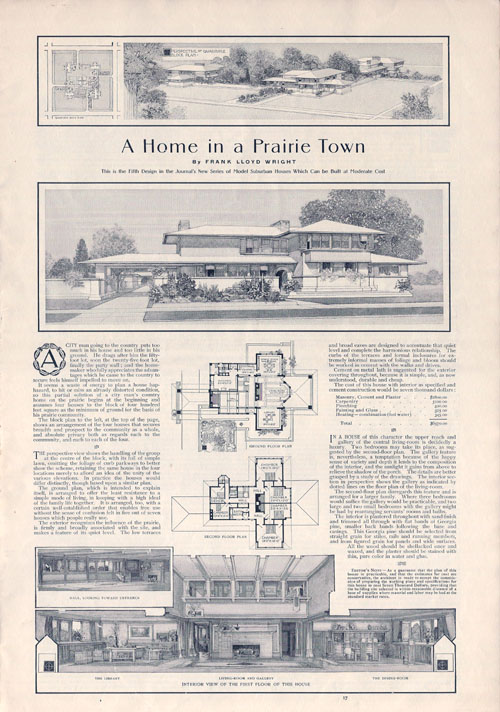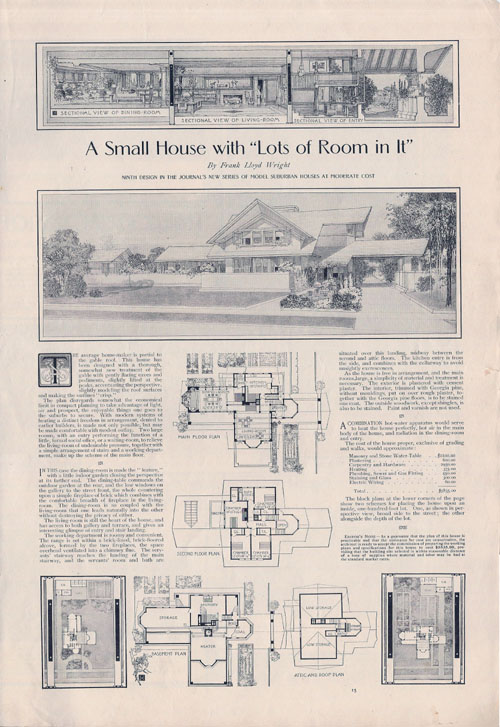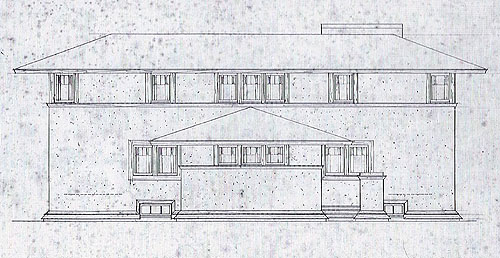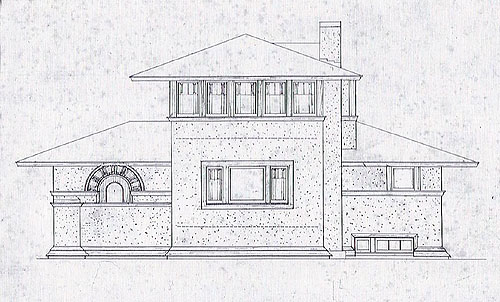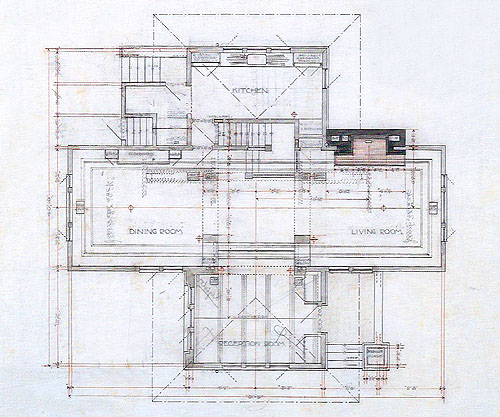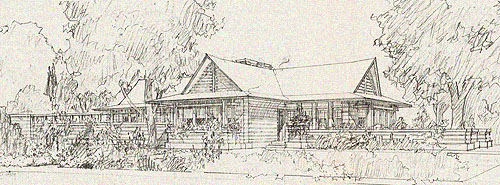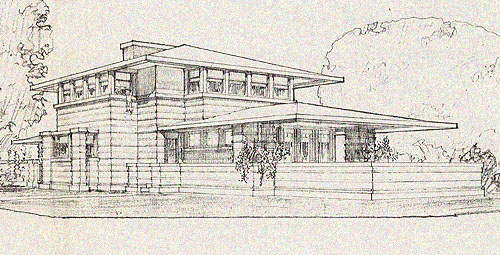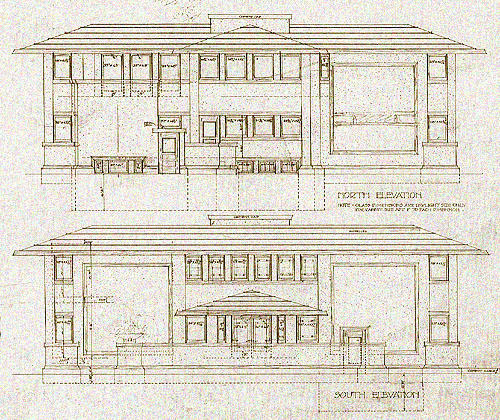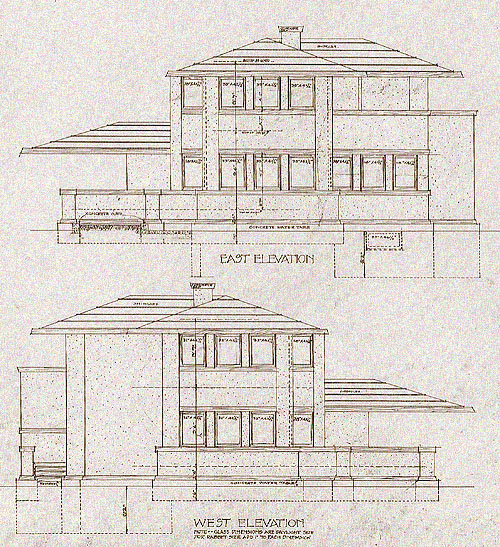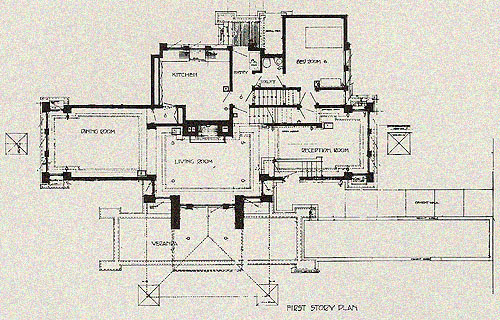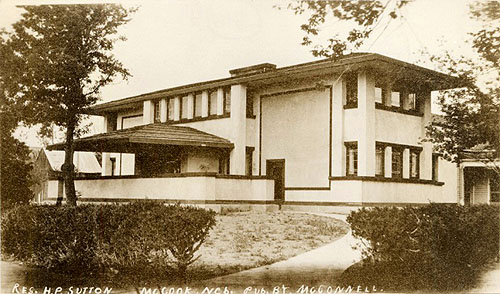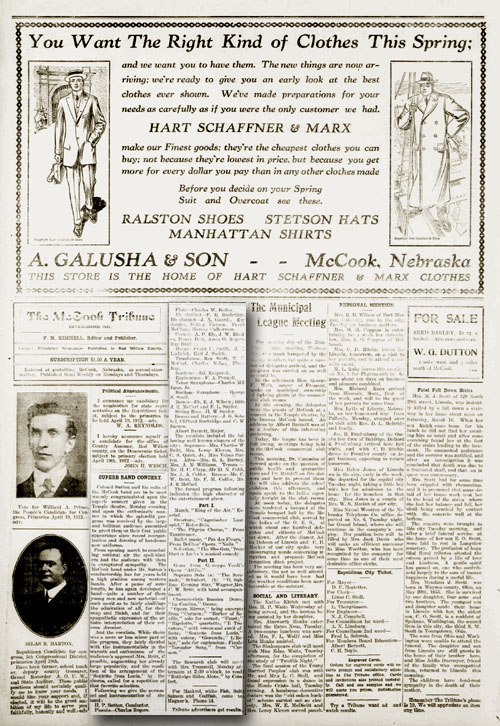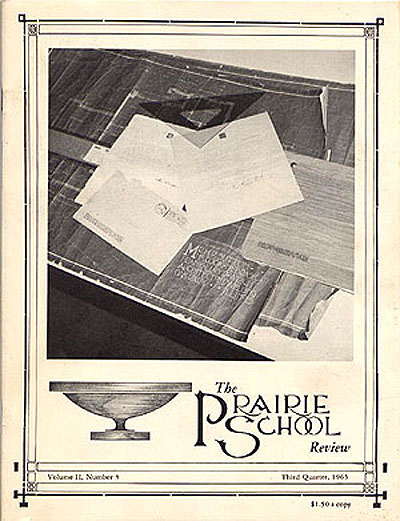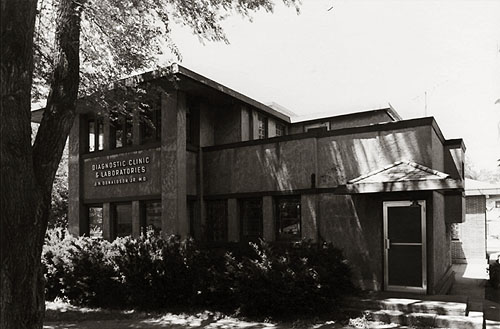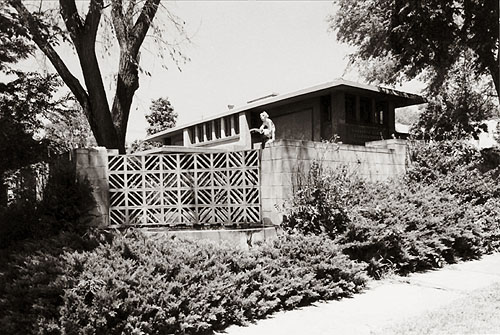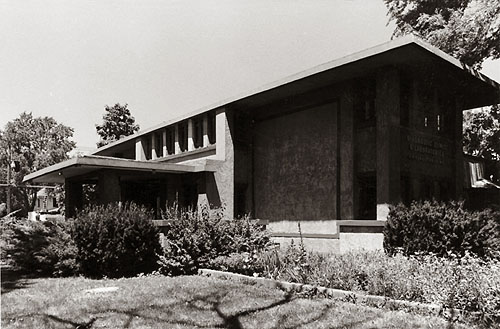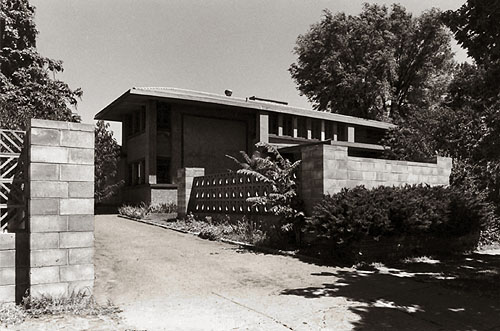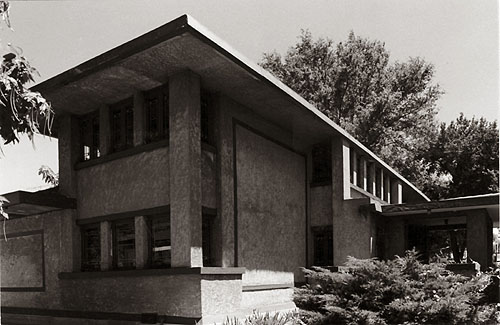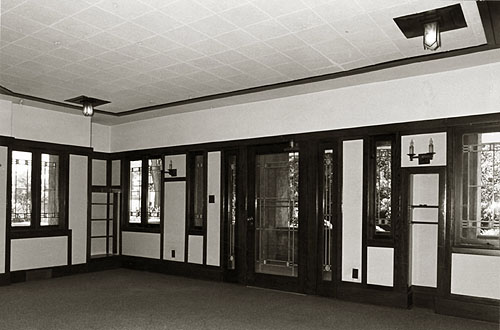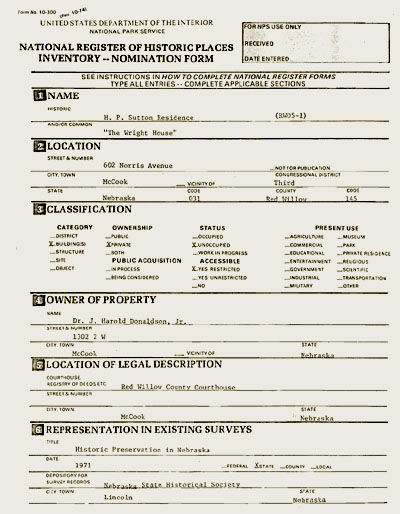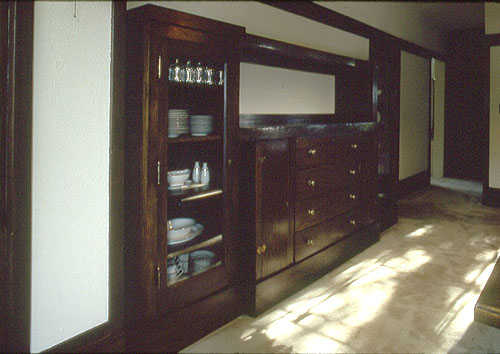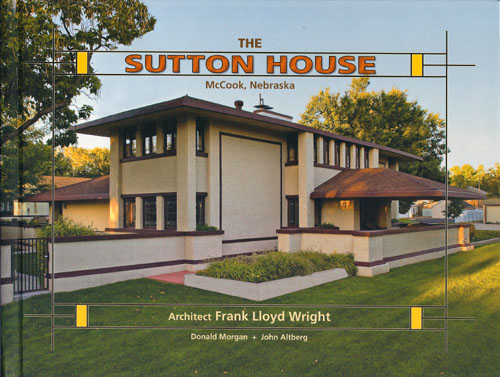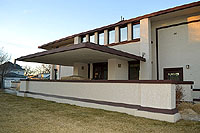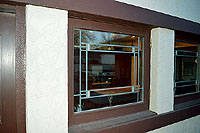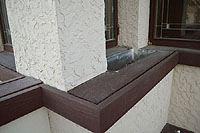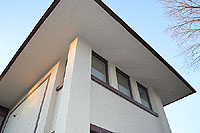- Wright Studies
- Harvey P. & Eliza Sutton Residence, McCook, Nebraska (1905 - S.106)
How often do you find yourself in McCook? It's 70 miles south of I-90, on the southern border of Nebraska. Unless you live close, probably rarely. Ours' turned out to be just that. On a recent trip with my daughter's family, driving from Chicago to Seattle, we found ourselves in North Platte at 3:30 pm on January 11. Timing was critical. My son-in-law and grandson had 5 minutes to find a restaurant with a television. The Seahawks/Saints playoff game was about to begin.
Knowing we had a couple of hours to kill, my daughter looked at me with a smile on her face, and asked if there were and Frank Lloyd Wright houses close by. What are the chances of having a couple hours to kill, and at the same time being within an hour of the only Wright home in Nebraska. Our enemy was daylight. Would we even make it there in time. With a returned grin on my face, we headed south.
In February, 1901, the Ladies Home Journal published A Home in a Prairie Town. Five months later they published A Small House with "Lots of Room in It", July both authored by Frank Lloyd Wright. "In these designs, Wright officially unveiled the Prairie House..." Manson, Frank Lloyd Wright to 1910, p.103. Manson continues, "These two original and revolutionary Prairie Houses, accorded the widest publicity then possible among American homeowners, had no immediate effect in the nation at large. They may have motivated some prospective clients in the Chicago area, but, with one exception, the Sutton house at McCook, Nebraska, no commissions came to The Studio (Oak Park) as a direct result of the publication of the model houses" (p.106).
But it did initiated an earlier project. Randy Stramel, a native of McCook, and at the time a student at the University of Nebraska School of Architecture, wrote his thesis on the Charles W. Barnes project. "The Sutton House", Morgan, Altberg, 2008, p.9. According to Stramel's thesis (1991), after reading the article, Barnes contacted Wright's office inquiring about a smaller version of the home published in the article. Nearly a year later 1902, Wright's office responded that there were none available, but that Wright would be more than happy to design a smaller home for him, "The 'Other' house", Discoe, 2011. Another year passed before plans for the home arrived. It would not be until 1903 that the first set of drawing would arrive in McCook.
Changes were made to the initial plans, and according to Morgan, Barnes traveled to Oak Park in August 1903 to finalize plans. The final floor plans were very similar to the floor plans of the Horner Residence (1908). A basic cruciform layout. The front door opens to a Reception Room. Up a few stairs, the Dining Room is on the left, the Living Room with a large fireplace is to the right. Straight ahead are the stairs that lead to the upper floor. Behind the stairs is the kitchen. Glancing at the exterior drawings, there are similarities to the Sutton Residence. Correspondence between Barnes and Wright's office ended in January of 1904, and unfortunately the project was never completed.The Barnes and the Suttons were neighbors and friends. It was through this relationship that the Suttons most likely were introduced to Wright. Eliza Sutton wrote in her first correspondence to Wright, "Having seen a plan you drew for Chas. Barnes and being favorable impressed, write to you to see if you can do something for me..." Morgan, p.12.
Harvey Putman Sutton was born in western New York State in 1860. When he was 8 years old, his father died. As a result, he and his mother moved to Dexter, Michigan, to live with an older brother who owned a jewelry store. His father was a musical instrument salesman, and past his love of music to his son Harvey, who traveled through Nebraska with the Forepaugh-Sells Circus band when he was 22 years old. According to the 1940 Who's Who, he was born on July 17, 1860. His parents were Joel C and Sarah (Robinson) Sutton. He married Eliza B. Munson on August 4, 1886 in Ainsworth, Nebraska. They had two children who survived, a son Harold P. and a daughter, Velma L. (Mrs. George Kisevalter Jr. Their son Robert Munson Sutton was born on February 22, 1891 and died on November 11, 1905.) From 1884-1889 he established and operated a jewelry store in Ainsworth. In April 1889 he established H. P. Sutton & Co., a jewelry store in McCook. From 1889-1924 he was the Chicago, Burlington and Quincy Railroad bandmaster in McCook. The band played at the Trans-Mississippi Exposition in Omaha 1898-99. He was very active in the community.
It seems safe to assume that music was his passion, jewelry was his job. He moved to McCook in 1889, the year he had the opportunity to become the bandmaster.
It took three attempts to satisfy Elizabeth Sutton, who took the lead in communicating with Wright's Oak Park office. She acted as contractor and seems to be the impetus behind the Suttons building a Wright home. Morgan had the opportunity to review the original correspondence between the Sutton and Wright's office. In his article "A Wright House on the Prairie", The Prairie School Review, Third Quarter 1965, and his book "The Sutton House", 2008, he does an excellent job of documenting the transition from Scheme #1 through the final Scheme #3. We are indebted. The Suttons began with a request for remodeling their existing home most likely in January 1905. On February 8, 1905, Wright's office responded and acknowledged receipt of the letter from the Suttons. It is followed by a letter dated March 24, and indicated that the sketches were sent out (Scheme #1), but did not include a second story to the remodel.
Obviously not pleased, because Mrs. Sutton had requested a second floor, Wright's office responded on April 18, 1905, indicating the sketches for an alternate scheme (#2), included a second floor. Mrs. Sutton was still "very unhappy" and on July 17, Wright's office sent a third scheme for an entirely new house. Correspondence continued for the next three years, and the home was finally completed around September of 1908.
Text by Douglas M. Steiner, Copyright January 2014
Ladies Home Journal, February 1901 In February, 1901, the Ladies Home Journal published "A Home in a Prairie Town," by Frank Lloyd Wright. "In these designs, Wright officially unveiled the Prairie House..." Manson, Frank Lloyd Wright to 1910, p.103. Manson continues, "These two original and revolutionary Prairie Houses, accorded the widest publicity then possible among American homeowners... Courtesy of the Ladies Home Journal. Ladies Home Journal, July 1901 In July, 1901, the Ladies Home Journal published "A Small House with 'Lots of Room in It' ", by Frank Lloyd Wright. "In these designs, Wright officially unveiled the Prairie House..." Manson, Frank Lloyd Wright to 1910, p.103. Manson continues, "These two original and revolutionary Prairie Houses, accorded the widest publicity then possible among American homeowners... Courtesy of the Ladies Home Journal
Charles W. Barnes Residence 1903 (Project) "Front elevation. The stairs leading to the front door are just to the right of the lower center wing. The front door opens to a Reception Room. Up a few stairs, the Dining Room is on the left, the Living Room with a large fireplace is to the right. Straight ahead are the stairs that lead to the upper floor. Behind the stairs is the kitchen. Courtesy of the Frank Lloyd Wright Foundation. See Additional information about the Charles W. Barnes Residence. "Side elevation. The front door, seen on the left, opens to a Reception Room. Up a few stairs, the Living Room with a large fireplace is in the center. The kitchen is on the right. Courtesy of the Frank Lloyd Wright Foundation. See Additional information about the Charles W. Barnes Residence. "Floor plan. Three stairs leading to the front door which opens to a Reception Room. Up a few stairs, the Dining Room is on the left, the Living Room with a large fireplace is to the right. Straight ahead are the stairs that lead to the upper floor. Behind the stairs is the kitchen. Courtesy of the Frank Lloyd Wright Foundation. See Additional information about the Charles W. Barnes Residence. Sutton Scheme #1 The Suttons began with a request for remodeling their existing home. On February 8, 1905, Wright's office responds and acknowledges receipt of the letter from the Suttons. It is followed by a letter dated March 24, and indicated that the sketches were sent out (Scheme #1), but did not include a second story to the remodel. Courtesy of the Frank Lloyd Wright Foundation. Sutton Scheme #2 Obviously not pleased, because Mrs. Sutton had requested a second floor, Wright's office responded on April 18, 1905, indicating the sketches for an alternate scheme (#2), included a second floor. Courtesy of the Frank Lloyd Wright Foundation. Sutton Scheme #3 North (back) elevation and South (front) elevation. Mrs. Sutton was still "very unhappy" with scheme #2, so on July 17, Wright's office sent a third scheme for an entirely new house. Correspondence continued for the next three years, and the home was finally completed around September of 1908. When viewing the front elevation, the dining room is on the left. The veranda is centered, with the living room and large centrally located fireplace behind it. The entrance is hidden to the right, leading to the reception room. Behind the living room and fireplace is the kitchen. To the right behind the the reception room is a bedroom. Courtesy of the Frank Lloyd Wright Foundation. East (right side) elevation and West (left side) elevation. East elevation: The cntilevered roof extends over the veranda. The reception room is in the center, a bedroom is on the right. Bedrooms are on the upper level. Courtesy of the Frank Lloyd Wright Foundation. Floor plan. The dining room is on the left. The veranda is centered, with the living room and large centrally located fireplace behind it. The entrance is hidden to the right, leading to the reception room. Behind the living room and fireplace is the kitchen. To the right behind the the reception room is a bedroom. Courtesy of the Frank Lloyd Wright Foundation. Sutton Home Circa 1908 "Res. H. P. Sutton McCook Neb. Pub. By McConnell." Real photo postcard circa 1908. Viewed from the Southeast. Lower level: the dining room is on the left, living room and terrace in the center, reception room on the right. Cantilevered roof extends over the veranda. Bedrooms are on the upper level. Courtesy of the Oak Park Public Library. The McCook Tribune, March 21, 1912 (Highlighted) SUPERB BAND CONCERT. Colonel Sutton and his colts of the McCook band are to be most warmly congratulated upon the superb concert given in the Temple theatre Monday evening, and upon the enthusiastic manner in which the splendid program was received by the large and brilliant audience assembled to greet them on their first public appearance since recent reorganization and donning of handsome new uniforms. From opening march to concluding national air the spell-binders had the audience with them in enraptured sympathy. The McCook band under Mr. Sutton's conductorship has for years held a high position among western bands. After a pause of some length he has again developed a band -- quite a number of them young men and new material -- of such merit as to fairly challenge the admiration of all for their snap and finish and for their sympathetic expression of the artistic interpretation of their veteran director. And the vocalists. While theirs was a more or less minor part of the program, they fairly divided with the instrumentalists in the warmth and enthusiasm of the audiences approval: Mrs. Britt if possible augmenting her already large popularity, and the rendition of the arrangement of the "Sextette from Lucia," by the chorus called for a repetition of that favorite selection. Following we give the personnel and of the band: H. P. Sutton, Conductor...
"A Wright House on the Prairie," Prairie School Review, 1965
Prairie School Review - No 3, 1965. (Published four times a year by the Prairie School Press, Park Forest, Illinois) Morgan, Donald
"A Wright House on the Prairie." Issue is devoted to the Sutton House. "The basic material for this study has been the letters, drawings, and notes preserved by the Sutton family for the past sixty years. The first systematic cataloging of these documents was undertaken by Don L. Morgan in 1965 while he was a student of architecture at the University of Nebraska." Includes 24 photographs and illustrations.
Sutton Residence 1977 After a fire in the home in 1932, the Suttons remodeled, creating two apartments upstairs, and a larger apartment on the lower level. Harvey and Eliza Sutton lived in their home until their death. In 1952, their son Harold and his wife Gladys moved into the home and occupied the first floor apartment. Harold was born on April 29, 1889, and past away on March 28, 1979. Gladys was born in 1892 and past away in 1976. They lived in the home for eight years, and sold it in 1960 to Dr. J. Harold Donaldson Jr. who remodeled it again to use as an office. He retired in 1977 and attempted to find a buyer who would preserve the home. Unable to, he worked toward having the home listed with the National Register of Historic Places. In June 1978, he was notified that the home was officially listed with the National Register of Historic Places, and that same month found buyers who desired to preserve the home, Mary and Don Poore. The following photographs were taken in 1977 by David Murphy.
Viewed from the East. The original first floor reception room in on the far left. The original bedroom is in the center. The bedroom wall was extended to the North by Dr. Donaldson, adding and exterior entrance. The addition added to the Northwest corner by Dr. Donaldson, can be seen on the far right. Photographed inside the wall by David Murphy. Viewed from the Southeast, the wall installed along the perimeter of the property, blocked the view of the home from the street, was added by Dr. Donaldson. Photographed from the street by David Murphy. Viewed from the Southeast. Ater the fire of 1932, columns were added to brace the roof on the far left, which cantilevered over the veranda. Dr. Donaldson removed front door and blocked off the entrance to the right of the veranda. It was moved to the entrance on the veranda. Photographed inside the wall by David Murphy. Viewed from the Southwest, the wall installed along perimeter of the property and the driveway were not part of the original plan. They were added by Dr. Donaldson Photographed from the street by David Murphy. Viewed from the Southwest. An addition, which was added by Dr. Donaldson, can be seen on the far left. The dining room is in the foreground on the first floor. Ater the fire of 1932, columns were added to brace the roof on the far right, which cantilevered over the veranda. Photographed inside the perimeter wall by David Murphy. View of the living room toward the veranda, looking Southeast. Dr. Donaldson extended the Southeast corner of the living room. He used the living room as the reception area, and used these veranda doors as the main entrance. He removed the double doors and replaced it with a single door (most likely the original front door) and two side art glass panels. Photographed from the fireplace by David Murphy. National Register of Historic Places 1978
National Register of Historic Places, H. P. Sutton Residence (Prepared by the Nebraska State Historical Society. Published by the United States Department of the Interior National Park Service, Washington, D.C.) Nebraska State Historical Society, D. Murphy
"The external appearance, like the interior, is a much simplified interpretation of Wright’s characteristic decorative vocabulary. Budget limitations (the house cost $10,000 to complete which was $5,000 over what the Suttons had wanted to spend) required the simplification. A strong horizontality persists in spite of the box-like two story mass of the whole. This is accentuated by the lines of the roof, the ribbons of casement windows at the ends of teach wing and by the dark painted wooden window heads and sills..." Includes six photographs by D, Murphy, 1977. 8.5 x 11
Sutton Dining Room 1990 Sutton Dining Room, 1990. After closing his practice in 1977, Dr. Donaldson was unable to find a buyer. Not wanting to see the home moved or demolished, Don and Mary Poore purchased the home in 1978. They began an extensive remodel, restoring the many of the changes back to its original state. The original sideboard was discovered in the basement. The Poores refinished it and returned it to it’s original location. Photographed by William Storrer. Courtesy of the Oak Park Public Library. The Sutton House 2008
The Sutton House, McCook Nebraska, Morgan, Donald; Altberg, John. Cornhusker Press, Hastings, Nebraska, 2008.
Publisher’s description: This compelling and comprehensive history begins with Harvey P. and Eliza Sutton’s interest in Frank Lloyd Wright’s house plans for McCook, Nebraska, resident Charles W. Barnes and Eliza’s 1903 trip to the Wright studio in Chicago. In addition to subsequent correspondence between Eliza and various principals of the Wright studio, including Frank Lloyd Wright, this account catalogs the myriad details that went into the creation of the Sutton House. Highlights include the construction of the house, the damage to the house as a result of a 1932 fire, the eighteen years use as a medical office, the struggle to save the house and the numerous renovation projects culminating with the current owners’ complete restoration, which incorporates extensive details from the original design and expanded modernization. Enhanced with 71 color and 25 black & white photographic images along with 29 original Frank Lloyd Wright Studio and additional drawings.Exterior Photographs By Douglas M. Steiner, January 2014
After closing his practice in 1977, Dr. Donaldson was unable to find a buyer. Not wanting to see the home moved or demolished, Don and Mary Poore purchased the home in 1978. They began an extensive remodel, restoring the many of the changes back to its original state. They moved into the home in 1979 and lived there for 10 years.
John and Staci Cannon purchased the home from the Poores in 1988 and lived in the home until 1992.
When the home became available, Jan and Van Korell purchased the home with the intent to restore the home to its original 1908 condition. That began the process which would last until 2001. Today, thanks to the Korell's extensive effort, we are able to once again, glimpse the Sutton home as Wright's intended in 1908.
Saturday, January 11 was an unseasonably warm 55 degrees. The average high for January 11 is normally 39 degrees, the low is 18 degrees. Earlier in the day, I-80 was down to 10 mph due to snow and ice on the roadway. We had passed a spot where two semis had been blown off the road and were neatly laying on their sides.
Not wanting to be too intrusive I knocked on the door and asked if I could photograph the outside of the home. John was very welcoming and said to let him know if I had any questions. The sun was beginning to set, casting an orange glow on the south and west sides of the home. After photographing the outside, and having a few questions, I knocked on the door. Jan answered this time, and invited me in to see the first floor.
Like many of Wright's homes, the front door is hidden in plain sight. The art glass door and windows were designed by Wright.Up five stairs to the right, you find yourself in the reception room. Warm colors fill your senses, rich wood tones, art glass, horizontal and vertical trim, bands of art glass windows, a row of upper spindles block the view of the stairs leading to the upper level. The Korells painstakingly restored every detail. The reception room is open all the way to the dining room, the full length of the home.
The massive centrally located fireplace dominates the living room. A ledge above the fireplace stays in line with the upper horizontal trim that borders the top of the windows and double doors that lead out to the veranda. Decorative items sit atop the ledge above the fireplace. The ceiling lights are original art glass fixtures. Period furniture finishes the room.
Offered separately during the 1977 sale of the house, the original dining room sideboard survived and sets against the North wall. A period dining room table and reproduction Robie house chairs set in the center of the dining room. For a more detailed history of the home see "The Sutton House", Morgan, Altberg, 2008.
There are many classic Wright details in this Prairie styled home. The basic materials are wood and stucco. Strong horizontal lines, broad overhanging eaves, horizontal rows of art glass windows and doors, the prominent centrally located fireplace and chimney, open first floor plan, cantilevered roof, anchoring the home by placing it on an enlarged concrete base.
After viewing the Sutton residence, we headed back to North Platte to meet up with my son-in-law and grandson. The Seahawks beat the Saints, 23 to 15, moving them closer to the Super Bowl.
Text by Douglas M. Steiner, Copyright January, 2014... Continue...
Text by Douglas M. Steiner, Copyright 2014
Related Books, Publications and Items
"Ladies Home Journal" , February, 1901 "Ladies Home Journal" , July, 1901 "In The Nature of Materials: 1887 - 1941", Hitchcock, 1942, p. 44. "Frank Lloyd Wright to 1910: The First Golden Age", Manson, 1958, pp. 106, 173. "A Wright House on the Prairie", The Prairie School Review, Margan, 1965, "Two Chicago Architects and Their Clients", Eaton, 1969, pp. 241, 249. "Frank Lloyd Wright Newsletter" - V1 #3 - May-June 1978, Heinz, "Frank Lloyd Wright: His Life and His Architecture", Twombly, 1979, pp. 81, 110–111. "The Decorative Designs of Frank Lloyd Wright", Hanks, 1979, p 221. "Frank Lloyd Wright Monograph 1902-1906", Vol. 2, Text: Pfeiffer, Bruce Brooks; Edited and Photographed: Futagawa, Yukio, 1986, (Barnes) pp 126-127, (Sutton #1 & 2) pp1172-174, (Sutton #3) pp. 175-177. "The Frank Lloyd Wright Companion", Storrer, 1993, pp 105-106. "National Register of Historical Places - Nebraska - Red Willow County". National Park Service. "Frank Lloyd Wright", McCarter, 1999, pp. 89-90. "Frank Lloyd Wright Field Guide", West, Heinz, 1999, p. 90. "The Vision of Frank Lloyd Wright", Heinz, 2000. pp 125, 127 "Frank Lloyd Wright Field Guide", Clayton, 2002, pp. 102, 126, 445. "The Sutton House", Morgan, Altberg, 2008. "Frank Lloyd Wright, Complete Works 1885-1916", Pfeiffer, 2011, pp. 208 (Barnes), 231-232 (Sutton). "The 'Other' house", Discoe, 2011 "Historic Postcards & Wright", Frank Lloyd Wright Quarterly - Spring 2011, pp. 18-23.
- Additional Wright Studies
- Adelman (S.344) Banff National Park Pavilion (S.170) Bitter Root Inn (S.145) Blair Residence (S.351) Blumberg Residence (Project)
Boomer Residence (1953 - S.361) Brandes Residence (S.350) Browne's Bookstore (S.141) Como Orchard Summer Colony (S.144)
Cooke Residence (1953) Copper Weed Urn & Weed Holder Disappearing City (1932) Elam Residence (S.336) "Eve of St. Agnes" (1896)
Feiman Residence (S.371) Frank L. Smith Bank (S.111) Gordon Residence (S.419) Griggs Residence (S.290) Hartford Resort (Project 1948)
Heller Residence (S.038) Henderson Residence (S.057) Hoffman Showroom (S.380) Horner Residence (S.142) "House Beautiful" 1896-98
Husser Residence (S.046) Imperial Hotel (S.194) Silverware and Monogram Japanese Print Stand (1908) Kalil Residence (S.387)
Lake Geneva Hotel (S.171) Lamp Cottage, Rocky Roost (S.021) Lockridge Medical Clinic (S.425) Lykes Residence (S.433)
Marden Residence (S.357) March Balloons Midway Gardens (S.180) Midway Gardens Dish (S.180) Nakoma Clubhouse
Nakoma Furniture Opus 497 Pebbles & Balch Remodel (S.131) Pilgrim Congregational Church (S.431) Loren B. Pope (S.268)
Roloson Rowhouse (S.026) Shavin Residence (S.339) Sixty Years Exhibition 1951-56 J. L. Smith Residence (1955) Steffens Residence (S.153)- Stohr Arcade (S.162) Stromquiest Residence (S.429) Sutton Residence (S.106) Teater Studio (S.352) Thurber Art Galleries (S.154)
- Tracy Residence (S.389) Trier Residence (S.398) Usonian Automatic Homes Williams (Way & Williams) (S.033)
Wyoming Valley School (S.401) Zimmerman Residence, (S.333)- Frank Lloyd Wright's First Published Article (1898)
- Photographic Chronology of Frank Lloyd Wright Portraits
"Frank Lloyd Wright's Nakoma Clubhouse & Sculptures." A comprehensive study of Wright’s Nakoma Clubhouse and the Nakoma and Nakomis Sculptures. Now Available. Limited Edition. More information.
HOME ARTIFACTS AUDIO BOOKS PERIODICALS PHOTOS POSTCARDS POSTERS STAMPS STUDIES ASSISTING ABOUT SLIDESHOW
SEARCH WEB SITE To donate or pass on information, comments or questions: info@wrightlibrary.com ©Copyright 2001, 2014
